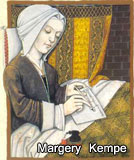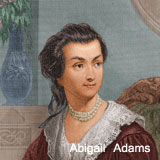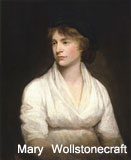Women in Genre Fiction
"Genre fiction" is a type of fiction that is plot-driven and designed to be read for pleasure; it has traditionally been distinguished from "literary fiction," which is considered to be more challenging in terms of character, theme and style. Each genre has specific characteristics--a set of "rules," so to speak--and readers of genre fiction expect the writer to conform to those rules.
There are many genres: action-adventure, mystery, horror, romance, science fiction, western, and inspirational, to name a few. Women have been writing in the genres since the beginning of the novel, although they have been found in some genres more than others.
Science fiction is typically considered a "male" interest, although the writer who invented science fiction was a woman--Mary Shelley, with her novel Frankenstein. And some of the best science fiction writers have been women: Andre Norton, C. L. Moore, Leigh Brackett, Ursula K. Le Guin, and Joanna Russ, among others.
Action-adventure is also typically considered a "male" genre...except for the many female action-adventure writers, such as Janet Evanovich, Patricia Cornwell, J. D. Robb, Dana Stabenow, Dorothy Gilman, and many others.
How about westerns? All male writers, right? Yes, except for Sandi Ault, Carol Buchanan, Lucia St. Clair Robson, Mary Sojourner, and Ellen Recknor. And don't forget Marguerite Roberts, who wrote such classic movie westerns as Ambush, 5 Card Stud, Shoot Out, and the 1969 version of True Grit, which starred John Wayne.
As you can see, women have made their names in all of the genres, especially romance and mystery.
Romance fiction as a genre is different from Romantic Literature, from the Romantic Period. Romance fiction has plots that revolve around love. There are, of course, conflicts, and there may even be some mysterious elements, but the focus of the plot is always the successful outcome of a romantic relationship. The Gothic Romance was extremely popular in the late 1700s and early 1800s. Horace Walpole's The Castle of Otranto was the first, and many women writers found a profession writing in this genre: Ann Radcliff (The Mysteries of Udolpho, Emily Bronte (Wuthering Heights), and Mary Elizabeth Braddon (Lady Audley's Secret), among others. Contemporary romance novelists number in the hundreds; some of the more prominent are Francine Rivers, Judith McNaught, Gail Carson Levine, Lisa Kleypas, Colleen McCullough, and Julie Garwood.
Edgar Allan Poe invented the mystery novel in 1841, with The Murders in the Rue Morgue. In 1878, Anna Katherine Green became the first woman to write a detective novel: The Leavenworth Case. In 1887, Arthur Conan Doyle introduced Sherlock Holmes, in A Study in Scarlet. Mary Roberts Rinehart became nationally famous after publishing her second mystery novel, The Circular Staircase, in 1908. And in 1920, Agatha Christie introduced Hercule Poirot in The Mysterious Affair at Styles. Today, there are dozens of women mystery writers: Sara Paretsky, Sue Grafton, Donna Andrews, Joan Hess, Carolyn Hart, Patricia Cornwell, Dorothy Cannell, Liza Cody, and Charlaine Harris, to mention just a few.
Mary Roberts Rinehart
Mary Roberts Rinehart was born in 1876 in Allegheny City, Pennsylvania. Her father was a prosperous sewing machine salesman and her mother was a dressmaker. As a child, Mary read avidly and was fascinated by the idea of storytelling; she began writing her own stories at a young age. When she was a teenager, her father's business failed and her mother began taking in roomers to make ends meet. Mary entered high school as an English major; she received only mediocre grades, a reflection of her difficulty coping with the problems in her home. Nevertheless, by the age of fiteen, she was the editor of her school's newspaper and was submitting stories to the Pittsburgh Press contests, and several were accepted and published.
After graduation, her uncle paid for her to attend nursing school. She did her training at a public hospital whose wards were full of workers, immigrants, prostitutes, and the homeless. Her experiences there later became material she would use in stories she wrote about nurses. She also met her husband there; he was a doctor, Stanley Rinehart. After she finished her training in 1896, they were married.
She had 3 sons, helped with her husband's medical practice, and wrote stories and poems in her spare time, making a small amount of money selling them to magazines. But in 1904, a stock market crash had a devastating effect on the family's finances, and Mary began writing more seriously to help make more money. Her first novel, The Circular Staircase, was published in 1908 and was an immediate success. The following year, her novel The Man in Lower Ten became the first mystery novel to make the bestseller list.
When World War I began in 1914, Rinehart asked the Saturday Evening Post to make her a correspondent. But in 1915, journalists weren't allowed to visit the front lines, so Rinehart used her nurse's training to get Red Cross credentials. She toured hospitals and interviewed the King of Belgium, Winston Churchill, and the Queen of England. The following year, she covered the political conventions and marched in a woman's suffrage parade. She traveled through the western United States and wrote about Indian reservations. Then she made a second trip to the European battlefields, sponsored by the War Department, in 1918. In 1920, she collaborated with Avery Hopwood on two plays which were enormously successful. And during all of this activity, she was also writing and publishing mystery novels--she wrote 5 novels between 1915 and 1919--and love stories and hospital stories.
Her husband died in 1932 and she moved to New York, dividing her time from then on between her apartment in New York and her home in Bar Harbor, Maine. She and her sons started a publishing house which published her works, along with others.
In 1946, Rinehart wrote and spoke publicly about her breast cancer. Breast cancer wasn't discussed openly at the time, but Rinehart felt it was necessary to share her knowledge to raise awareness and encourage women to have examinations.
Rinehart wrote prolifically until near the end of her life. Her last story was published in 1954. By the time she died in 1958, her works had sold over 10 million copies in 14 languages.
Agatha Christie
Agatha Christie never set out to be a mystery writer--or any kind of writer, for that matter. She was born in 1890 and brought up in a comfortable, well-regulated home in Torquay, England. She had an older brother and sister, but they were away at school for most of her childhood, so she was, in effect, an only child who spent her time inventing adventures for imaginary friends. She also read voraciously. Her mother believed that reading was bad for a young child's eyes, but Agatha learned anyway, before she was five. She remembers hearing her nurse report this to her mother: "I'm afraid, ma'am...Miss Agatha can read."
Agatha was not a spoiled child, though: like most Victorian children, she was expected to learn manners, perform various chores, and behave well. She learned self-discipline and control and how to accept responsibility for her actions.
Compared to her very intelligent mother and sister, Agatha was considered to be "slow." She was also inarticulate. She was not sent to school and didn't even have a regular governess, although she did have a teacher for 3 years, went to dancing school, and then to a series of schools in France to study music. For a time, the teenage Agatha thought she wanted to be a concert pianist or a singer, but her voice wasn't strong enough for an operatic career, and she had too much stage fright to perform on stage.
So she turned to writing. She wrote several short stories and a novel which was not accepted for publication. But perhaps the most influential event in her life at this time was an offhand remark by her older sister, who said that detective fiction would be too difficult for Agatha to write. That made her determined to write a detective novel.
But first there was World War I. Agatha had met a young man named Archibald Christie; they were married just before he left for France to serve in the Flying Corps. Agatha spent the war working as a V.A.D. (Voluntary Aid Detachment) nurse at a hospital in Torquay.
She didn't get around to writing her detective novel until she had a two-week leave from the hospital in 1916. She finished The Mysterious Affair at Styles, her first published novel, and the one in which she introduced Hercule Poirot, in that two weeks. Five publishing houses rejected it before it was accepted and published in 1920.
The Secret Adversary was published in 1922, followed The Man in the Brown Suit (1924), The Secret of Chimneys (1925), and others. In 1926, The Murder of Roger Ackroyd was published; it was hugely successful. But that year was a bad one for Agatha: her mother died, and while she was trying to put her mother's affairs in order, her husband told her he'd been having an affair. She had a breakdown and disappeared for 10 days. Her car was found abandoned. She was discovered by police in a hotel 10 days later, registered under the name of her husband's mistress. She claimed amnesia, and various biographers have differed on whether or not her story was true. Either way, she was divorced in 1928.
The following year she met Max Mallowan, an archaeologist, and they were married in 1930. She worried about the differences between them: he was Roman Catholic and she was Anglican; he was 14 years younger than she was. Nevertheless, they married, and their 45-year marriage was a success. They lived in England, but she frequently accompanied him on his digs in Syria and Iraq, and despite (or perhaps because of) all the travel, she settled into a routine of writing two or three books a year.
World War II was a difficult time--Agatha called it "a nightmare in which reality stopped." Her husband was stationed in North Africa; her daughter's husband was killed in action; and Agatha worked in a dispensary and wrote feverishly to blot out the fear and anxiety.
After the war, she and Max began reconstructing their private and professional lives, and Agatha added playwriting to her resume: Appointment With Death (1945), Murder on the Nile (1946), and Murder at the Vicarage (1949), among others. The most successful of them all was The Mousetrap (1951), which ran continuously for over 30 years.
Christie wrote until near the end of her life. In 1971, she was named a Dame of the British Empire; and she died in 1976. During her life, she wrote 93 books, 17 plays, and numerous short stories. Her books have sold over 400 million and have been translated into 104 languages.
If you'd like more information on any of the topics covered in this lecture, go to the Links page. Enjoy!
Some of the information in this lecture derives from:
1. Blanche Colton Williams, "Mary Roberts Rinehart." Our Short Story Writers.
2. Sally Mitchell, "Mary Roberts Rinehart." Critical Survey of Mystery and Detective Fiction.
3. Bryce Lambert, "Rinehart, Mary Roberts." Pennsylvania Center for the Book, 2005.
4. Mary S. Wagoner, Agatha Christie.
5. "Agatha Christie." Encyclopedia of Wold Biography.


